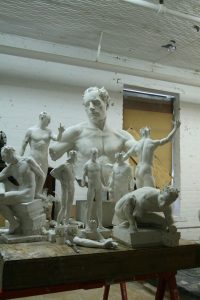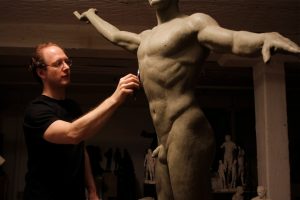My speech at the ICAA for the BOOK LAUNCH/SCULPTURE SHOW
My speech at the ICAA
WELCOME to this book launch and celebration of classical art!!
TRACI L. SLATTON
Author Blog

My speech at the ICAA
WELCOME to this book launch and celebration of classical art!!

Sabin Howard Sculpture: DAILY NEWS ONLINE: SABIN HOWARD CREATES CLASSICAL …: Check out this article online about Sabin’s studio in the Bronx.
Artist creates classical bronze sculptures of Greek gods and goddesses in Mott Haven
Walking into Sabin Howard‘s studio in Mott Haven is like stepping into a fine art gallery.
Clay and bronze statues of the Greek gods Hermes, Apollo and Aphrodite among others fill the 1,500-square foot studio.
“I am trying to return art to its sacred form,” he said, while working on pieces to be exhibited at the Institute of Classical Architecture and Art in Manhattan.
The gallery show, “Sabin Howard – The Classical Art of Sculpture,” opens Friday with a special reception and launch of his new book, The Art of Life.
“Post modern art is sacred to me,” said Howard, 48, of Manhattan. “I really got into it when I was in Italy. It affected me and I wanted to be surrounded by beauty. I didn’t want to make things that were just visually beautiful. I wanted to tell a story.”
Howard studied art at the Philadelphia College of Art and the New York Academy of Art. He taught for 20 years before turning to sculpture full time.
For Howard, the sculpture process starts with a live model. Then he builds an armature – steel bars welded together to resemble a stick figure – to fit within the figure. He then glues styrofoam onto the form.
Next, he adds clay. This is the most time consuming part. A life-sized piece of Aphrodite, for example, took 18 months to complete. And he’s been crafting a 28-inch statue of Apollo since last April, at times adding pieces of clay no bigger than a pinhead.


Sabin Howard: The Man Who Sculpts Gods Epoch Times by Evan Mantyk and Katy Mantyk
“NEW YORK—Entering Sabin Howard’s studio in the Bronx is a unique experience. Through his lifelike sculptures, the gods’ penetrating stares are both humbling and uplifting.
“Collectors like them for their homes because they change the energy of a room,” said Howard.
Howard, who has spent his life between Italy and New York, stood in front of a sculpture of Apollo—God of the Sun from the Greek and Roman tradition—with perfect physique and graceful pose.
“You can see I extended the sternum and lifted it up toward the sky, so there’s more luminosity coming onto the chest—and that’s where your heart chakra is—then the openness with the arms stretched outward. It’s really about the possibility of what we can be,” Howard said.
The Apollo sculpture alone took Howard more than five years and $85,000 to produce, including materials and paying two models to pose for long hours.
Reflecting on Howard’s work, Stefano Acunto, chairman of the Italian Academy Foundation (IAF), said, “The word ‘masterpiece’ in Italian is ‘capolavori’—’lavori’ means to labor, to work. And you really see that in Sabin’s sculptures.”
The hard work paid off. After Sabin makes a first sculpture, he can create a mold and is able to make a series. With around 180 collectors worldwide, he sold the first three in the Apollo series for within the six-figure range and plans to create six more.
Presented by the IAF, Howard’s work, including his sculptures of Apollo and Greek gods Aphrodite and Hermes, will be on exhibit March 2 through March 22 at the Institute for Classical Architecture and Art (ICAA), at the institute’s historic West 44th Street headquarters.
Why does he often sculpt gods? “I pick titles that are universal, that can be understood by the community, and art is in service of the community,” Howard said.
Howard’s work is something that can be instantly appreciated for its masterful skill.
“The UPS guy and the fireman understand it; they walk in here and go, ‘Wow, this is real art,’” Howard said.
But his sculptures also stand in opposition to the many more abstract sculptures that have become the bread and butter of modern sculptors and the center of the contemporary art world.
“What Sabin is doing is so important because his work reflects on themes and techniques that are the basis of art, which are ignored so often in the production of contemporary art, which is more temporary than anything else,” Acunto said.
Howard, 48, said that the modern art of the last 50 to 60 years has gotten too entrenched in academic language.
“Now the conceptual part and the manual … [have] become more important than the art itself. So you read all this philosophy about the work, and there’s nothing wrong with that per se. But when that becomes more important than the actual object—and the actual object might be a pile of cinder blocks on the floor—then I have a problem because art represents me on a cultural level,” said Howard, who taught figure sculpture and drawing at the graduate level for 20 years.
“I don’t want to be represented by, say, pieces of mud smeared on canvas, or a pile of bricks. I want to be represented by art that really shows us rising to the occasion as human beings,” he said.
Howard isn’t alone. His exhibit at the ICAA will open on March 2 with a panel that also features other leading exponents of classicism in art, including editor of Fine Art Connoisseur, Peter Trippi, and editor of American Arts Quarterly, James Cooper.“

Lively, appealing, informative Londoncalling.com posted a thoughtful interview of me and my husband Sabin Howard. We answered questions about our book THE ART OF LIFE.
Check out the article here.
London Calling talked to sculptor Sabin Howard and his wife, author Traci L. Slatton, about their collaborative book, The Art of Life, a collection of essays and visually stunning photography detailing Sabin’s equally stunning sculptural work.
London Calling: What was the original genesis for the book project and how long did it take to complete?
Traci L. Satton: Sabin claims that he was talking about his work one morning, as he does obsessively, and I said, “We have to write a book. People need to know what you’re doing and why it matters.”
Sabin Howard: The whole idea was to reach a broader audience and to educate them. People have lost the concept that they can have an opinion about art that is contrary to the established academic status quo. The art world is run by critics and academicians who are not trained in the visual, but who are more trained as writers writing a manual explaining art. I see the title “visual art” as self explanatory. Art is visual first and foremost. The book returns to the idea that you need to look at the piece and be with it. Then you can write or talk about it. It’s not the other way around, as current “concept art” espouses.
LC: The book is very personal, almost a love letter in places. Was it a challenge making a book so close to home?
TLS: Yes! Sometimes our discussions grew rousing. Names might have been called, objects might have been hurled.
SH: Making the type of art that I do is already extremely personal. I understand that any choices I make in my art expose how I think. If you look at my sculptures, they are completely out in the open because they are nude. Explaining the human and personal process of making my art was not uncomfortable. Without Traci, I wouldn’t have been able to put this in writing that was accessible to the general public. I would write something that was more esoteric. It was really important that I follow Traci’s lead in how the narrative was assembled.

Author of “Across the Pond”

![]()
My husband classical figurative sculptor SABIN HOWARD will be life on
A Book and A Chat hosted by Barry Eva.
Listeners can call in to 347-237-5398.
